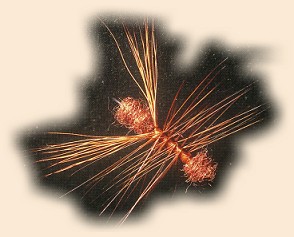The Ant Carol
By Skip Morris
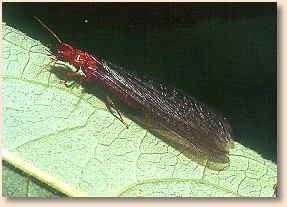 Flying ants, though the fishing books and magazines
seldom mention them, can be serious business to the
fly fisher. I've seen flying ants as tiny as size-24
hooks sprinkled like gray dust over the surface of a
Montana lake; and I've caught good trout out in water
sixty feet deep that were hunting the surface for flying
ants with thick brown bodies. But where I live on
Washington State's Olympic Peninsula the most important
flying ant is the termite. Brown-orange bodied with long
brown wings, it begins its nervous flights in the hot
evenings of mid-August and continues them into the first
part of September. It's big, as trout-food insects go,
calling for a size-10 or -12 hook for imitation, and it
can hit the lakes in respectable numbers on the best days.
I've seen largemouth bass uncharacteristically far out
from shore quietly picking termites from the surface
like trout. And I'm sure that bluegills and some of
the other pan fishes also occasionally focus on termites.
But despite that other fishes have a taste for them,
termites and all other flying ants I think of as trout
food. And though termites and their relatives must drop
onto streams, again becoming fare for trout, I nonetheless
think of them as trout food of lakes.
Flying ants, though the fishing books and magazines
seldom mention them, can be serious business to the
fly fisher. I've seen flying ants as tiny as size-24
hooks sprinkled like gray dust over the surface of a
Montana lake; and I've caught good trout out in water
sixty feet deep that were hunting the surface for flying
ants with thick brown bodies. But where I live on
Washington State's Olympic Peninsula the most important
flying ant is the termite. Brown-orange bodied with long
brown wings, it begins its nervous flights in the hot
evenings of mid-August and continues them into the first
part of September. It's big, as trout-food insects go,
calling for a size-10 or -12 hook for imitation, and it
can hit the lakes in respectable numbers on the best days.
I've seen largemouth bass uncharacteristically far out
from shore quietly picking termites from the surface
like trout. And I'm sure that bluegills and some of
the other pan fishes also occasionally focus on termites.
But despite that other fishes have a taste for them,
termites and all other flying ants I think of as trout
food. And though termites and their relatives must drop
onto streams, again becoming fare for trout, I nonetheless
think of them as trout food of lakes.
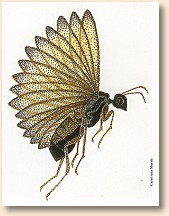
My imitation of the termite, the Ant Carol, evolved over
two decades of hunting lakes for trout (and sometimes bass)
that were themselves hunting termites. It sort of developed
on its own, along that oft-mentioned path of least resistance,
replacing or revising inefficient aspects of its design and
shedding unnecessary parts along the way. Simplicity in a
fly pattern (that is, a fly pattern intended for fish rather
than for displaying behind glass) must always be a virtue,
and the Ant Carol is simple indeed. It's buck-tail wings
are spare enough to suggest the veined translucent-brown
wings of the natural, supple enough to flex and let the
hook do its job, stiff enough to hold their shape through
the rigors of riding out casts and catching fish. Its body
of synthetic dubbing is buoyant (like the wings, when they've
been treated with floatant). Its hackle is sparse enough
to suggest a few legs. One could start over with a whole
new design to improve buoyancy extend the body and reduce
the mass of the hook; make the body of something incapable
of absorbing water, like closed-cell foam but that would
make a heavier demand on the tier, and there is no pressing
need for great buoyancy in a dry fly that, like the Ant Carol,
is only quietly manipulated on standing water. Besides, flying
ants seem heavy and their fall to water is usually harsh, so
they often wind up a bit low in the surface of the water...
about as low in the surface as an Ant Carol lies.
A simple fly for a simple job. But an effective fly,
especially when fish are seeking flying ants atop lakes.
Materials for the Ant Carol:
Hook: Light wire, standard length to IX long (standard
dry-fly hook), sizes 12 and 10 (smaller or larger for imitating
flying ants other than the termite, size 20 even smaller if
you dare up to size 8, though I seldom go smaller than 14 and
never larger than 8).
Thread: Red 8/0 or 6/0 (for versions other than the
red-orange termite, thread-color should echo body-color).
Abdomen: Red-orange synthetic dubbing (or some other
ant-color, typically black or brown) poly, Superfine, Antron...
Wings: Brown buck tail.
Thorax: The same as the abdomen.
Hackle: One, brown (or whatever color imitates the natural).
Tying Instructions for the Ant Carol:
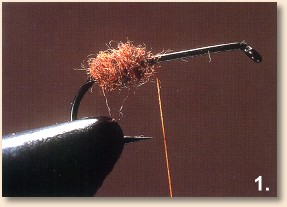
1. Start the thread at the hook's bend. Dub a full,
rounded abdomen over the rear third of the hook's
shank. (You can dub down the bend a little, if you
like.)
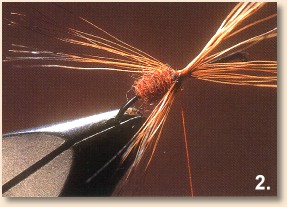
2. Cut a small bunch of hair from the natural-brown
area of an undyed buck tail. Use the long stiff hairs,
not the short soft ones. Comb out the short hairs and
under-fur. Stack the hairs in a hair-stacking tool.
Bind half the hairs on one side of the abdomen, half
on the other. The abdomen should push the two bunches
out to the sides in a shallow "V". The length of the
wings should equal the full length of the hook, or be
slightly longer.
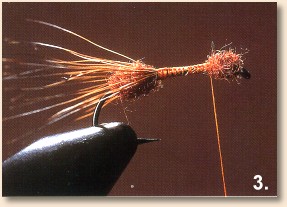
3. Bind the butts of the hairs tightly along the shank
to just back from the hook's eye. Trim the butts. Build
another bulge of dubbing just behind the eye. Build it
to only about half to two-thirds the length and diameter
of the abdomen. End with the thread behindthe dubbing.
(An alternate approach for the wings: bind them as a
single bunch atop the hook, right back to the abdomen,
then split them with crisscrossed turns of thread.)
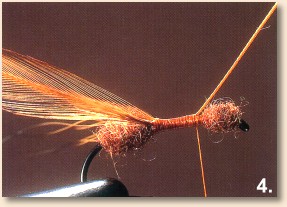
4. Spiral the thread back to the wings and take a turn
or two of thread around each, if needed, to gather them
into distinct bunches. Remember that tight thread-turns
will flare the hair, firm turns will gather it.
Select a proper-size hackle from a dry-fly neck or saddle
using a hackle gauge. Strip the long, soft fibers from the
base of the hackle's stem. Bind the hackle to the shank
at the front of the abdomen. Bind the stem along the
shank most of the way to the dubbed thorax. Trim the
stem closely.

5. Wind the hackle forward in a few open spirals; the
result should be sparse. Bind the hackle's tip just short
of the thorax. Whip finish the thread behind the thorax,
cut it, and add head cement to the whip finish.
You can trim the hackle fibers away underneath, for
perhaps a touch more realism, but I haven't yet felt
the need.
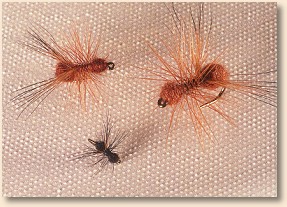
~ Skip Morris
Credits: The Ant Carol is from Skip Morris's book,
Morris on Tying Flies, published by Frank Amato
Publications, (2006). The book contains seventy-four patterns,
Skip's favorites, updated from top to bottom.
|

